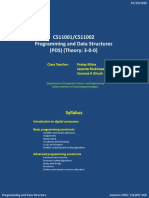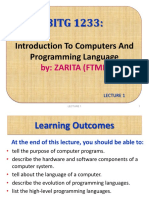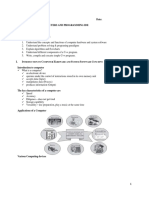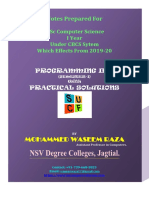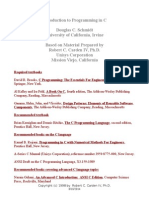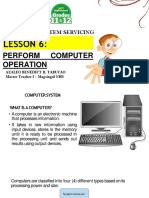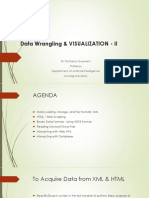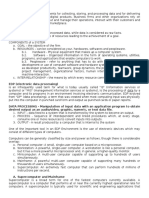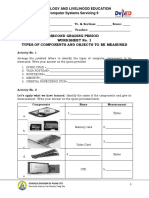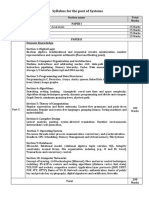Programming and Data Structure
Sujoy Ghose
Sudeshna Sarkar
AND
Jayanta Mukhopadhyay
Dept. of Computer Science & Engineering.
Indian Institute of Technology
Kharagpur
Spring Semester 2012
Programming and Data Structure
�Some General Announcements
Spring Semester 2012
Programming and Data Structure
�About the Course
L-T-P rating of 3-1-0.
There is a separate laboratory of 0-0-3.
Grading will be separate.
Tutorial classes (one hour per week) will be
conducted on a per section basis.
Evaluation in the theory course:
Mid-semester
End-semester
Two class tests and attendance
Spring Semester 2012
Programming and Data Structure
30%
50%
20%
3
�Course Materials
The slides for the lectures will be made
available on the web (in PDF form).
http://144.16.192.60/~pds
All important announcements will be put up
on the web page.
Spring Semester 2012
Programming and Data Structure
�ATTENDANCE IN THE CLASSES IS MANDATORY
Students having poor attendance will be
penalized in terms of the final grade /
deregistration.
Any student with less than 75% attendance
would be debarred from appearing in the
examinations.
Spring Semester 2012
Programming and Data Structure
�Text/Reference Books
1. Kernighan and Ritchie
2. Programming with C
B.S. Gottfried, Schaums Outline Series, Tata
McGraw-Hill, 2006.
Spring Semester 2012
Programming and Data Structure
�Introduction
Spring Semester 2012
Programming and Data Structure
�What is a Computer?
It is a machine which can accept data, process them,
and output results.
Input
Device
Central
Processing
Unit
(CPU)
Output
Device
Main Memory
Storage Peripherals
Spring Semester 2012
Programming and Data Structure
� CPU
All computations take place here in order for the
computer to perform a designated task.
It has a large number of registers which temporarily
store data and programs (instructions).
It has circuitry to carry out arithmetic and logic
operations, take decisions, etc.
It retrieves instructions from the memory, interprets
(decodes) them, and perform the requested
operation.
Spring Semester 2012
Programming and Data Structure
� Main Memory
Uses semiconductor technology
Allows direct access
Memory sizes in the range of 256 Mbytes to
Gbytes are typical today.
Some measures to be remembered
1 K = 210 (= 1024)
1 M = 220 (= one million approx.)
1 G = 230 (= one billion approx.)
Spring Semester 2012
Programming and Data Structure
10
� Input Device
Keyboard, Mouse, Scanner, Digital Camera
Output Device
Monitor, Printer
Storage Peripherals
Magnetic Disks: hard disk, floppy disk
Allows direct (semi-random) access
Optical Disks: CDROM, CD-RW, DVD
Allows direct (semi-random) access
Flash Memory: pen drives
Allows direct access
Magnetic Tape: DAT
Only sequential access
Spring Semester 2012
Programming and Data Structure
11
�Typical Configuration of a PC
CPU:
Main Memory:
Hard Disk:
Floppy Disk:
CDROM:
Input Device:
Output Device:
Ports:
Spring Semester 2012
Pentium IV, 2.8 GHz
512 MB
80 GB
Not present
DVD combo-drive
Keyboard, Mouse
17 color monitor
USB, Firewire, Infrared
Programming and Data Structure
12
�How does a computer work?
Stored program concept.
Main difference from a calculator.
What is a program?
Set of instructions for carrying out a specific task.
Where are programs stored?
In secondary memory, when first created.
Brought into main memory, during execution.
Spring Semester 2012
Programming and Data Structure
13
�Number System :: The Basics
We are accustomed to using the so-called
decimal number system.
Ten digits :: 0,1,2,3,4,5,6,7,8,9
Every digit position has a weight which is a
power of 10.
Example:
234 = 2 x 102 + 3 x 101 + 4 x 100
250.67 = 2 x 102 + 5 x 101 + 0 x 100 + 6 x 10-1
+ 7 x 10-2
Spring Semester 2012
Programming and Data Structure
14
�Contd.
A digital computer is built out of tiny
electronic switches.
From the viewpoint of ease of manufacturing and
reliability, such switches can be in one of two
states, ON and OFF.
A switch can represent a digit in the so-called
binary number system, 0 and 1.
A computer works based on the binary
number system.
Spring Semester 2012
Programming and Data Structure
15
�Concept of Bits and Bytes
Bit
A single binary digit (0 or 1).
Nibble
A collection of four bits (say, 0110).
Byte
A collection of eight bits (say, 01000111).
Word
Depends on the computer.
Typically 4 or 8 bytes (that is, 32 or 64 bits).
Spring Semester 2012
Programming and Data Structure
16
�Contd.
A k-bit decimal number
Can express unsigned integers in the range
0 to 10k 1
For k=3, from 0 to 999.
A k-bit binary number
Can express unsigned integers in the range
0 to 2k 1
For k=8, from 0 to 255.
For k=10, from 0 to 1023.
Spring Semester 2012
Programming and Data Structure
17
�Classification of Software
Two categories:
1. Application Software
Used to solve a particular problem.
Editor, financial accounting, weather forecasting, etc.
2. System Software
Helps in running other programs.
Compiler, operating system, etc.
Spring Semester 2012
Programming and Data Structure
18
�Computer Languages
Machine Language
Expressed in binary.
Directly understood by the computer.
Not portable; varies from one machine type to
another.
Program written for one type of machine will not run
on another type of machine.
Difficult to use in writing programs.
Spring Semester 2012
Programming and Data Structure
19
�Contd.
Assembly Language
Mnemonic form of machine language.
Easier to use as compared to machine language.
For example, use ADD instead of 10110100.
Not portable (like machine language).
Requires a translator program called assembler.
Assembly
language
program
Spring Semester 2012
Assembler
Programming and Data Structure
Machine
language
program
20
�Contd.
Assembly language is also difficult to use in
writing programs.
Requires many instructions to solve a problem.
Example: Find the average of three numbers.
MOV
ADD
ADD
DIV
MOV
Spring Semester 2012
A,X
A,Y
A,Z
A,3
RES,A
;
;
;
;
;
A=X
A=A+Y
A=A+Z
A=A/3
RES = A
Programming and Data Structure
In C,
RES = (X + Y + Z) / 3
21
�High-Level Language
Machine language and assembly language are
called low-level languages.
They are closer to the machine.
Difficult to use.
High-level languages are easier to use.
They are closer to the programmer.
Examples:
Fortran, Cobol, C, C++, Java.
Requires an elaborate process of translation.
Using a software called compiler.
They are portable across platforms.
Spring Semester 2012
Programming and Data Structure
22
�Contd.
HLL
program
Executable
code
Compiler
Object code
Linker
Library
Spring Semester 2012
Programming and Data Structure
23
�To Summarize
Assembler
Translates a program written in assembly language
to machine language.
Compiler
Translates a program written in high-level
language to machine language.
Spring Semester 2012
Programming and Data Structure
24
�Operating Systems
Makes the computer easy to use.
Basically the computer is very difficult to use.
Understands only machine language.
Operating systems make computers easy to use.
Categories of operating systems:
Single user
Multi user
Time sharing
Multitasking
Real time
Spring Semester 2012
Programming and Data Structure
25
�Contd.
Popular operating systems:
DOS:
Windows 2000/XP:
Unix:
Linux:
single-user
single-user multitasking
multi-user
a free version of Unix
The laboratory class will be based on Linux.
Question:
How multiple users can work on the same
computer?
Spring Semester 2012
Programming and Data Structure
26
�Contd.
Computers connected in a network.
Many users may work on a computer.
Over the network.
At the same time.
CPU and other resources are shared among the
different programs.
Called time sharing.
One program executes at a time.
Spring Semester 2012
Programming and Data Structure
27
�Multiuser Environment
Computer Network
Computer Computer Computer Computer Computer Computer
User 1
Spring Semester 2012
User 2
User 3
User 4
Programming and Data Structure
User 4
Printer
28
�Basic Programming Concepts
Spring Semester 2012
Programming and Data Structure
29
�Some Terminologies
Algorithm / Flowchart
A step-by-step procedure for solving a particular
problem.
Should be independent of the programming
language.
Program
A translation of the algorithm/flowchart into a
form that can be processed by a computer.
Typically written in a high-level language like C,
C++, Java, etc.
Spring Semester 2012
Programming and Data Structure
30
�Variables and Constants
Most important concept for problem solving
using computers.
All temporary results are stored in terms of
variables and constants.
The value of a variable can be changed.
The value of a constant do not change.
Where are they stored?
In main memory.
Spring Semester 2012
Programming and Data Structure
31
�Contd.
How does memory look like (logically)?
As a list of storage locations, each having a unique
address.
Variables and constants are stored in these
storage locations.
Variable is like a house, and the name of a variable
is like the address of the house.
Different people may reside in the house, which is like
the contents of a variable.
Spring Semester 2012
Programming and Data Structure
32
�Memory map
Address
Address
Address
Address
Address
Address
Address
0
1
2
3
4
5
6
Every variable is
mapped to a
particular memory
address
Address N-1
Spring Semester 2012
Programming and Data Structure
33
�Variables in Memory
Instruction executed
T
i
m
e
Spring Semester 2012
Memory location
allocated to a variable X
X = 10
10
X = 20
20
X=X+1
21
X=X*5
105
Programming and Data Structure
34
�Variables in Memory (contd.)
Variable
Instruction executed
T
i
m
e
Spring Semester 2012
X = 20
20
Y = 15
20
15
X=Y+3
18
15
Y=X/6
18
Programming and Data Structure
35
�Data types
Three common data types used:
Integer :: can store only whole numbers
Examples: 25, -56, 1, 0
Floating-point :: can store numbers with fractional
values.
Examples: 3.14159, 5.0, -12345.345
Character :: can store a character
Examples: A, a, *, 3, , +
Spring Semester 2012
Programming and Data Structure
36
�Data Types (contd.)
How are they stored in memory?
Integer ::
16 bits
32 bits
Float ::
32 bits
64 bits
Actual number of bits
varies from one
computer to another
Char ::
8 bits (ASCII code)
16 bits (UNICODE, used in Java)
Spring Semester 2012
Programming and Data Structure
37
�Problem solving
Step 1:
Clearly specify the problem to be solved.
Step 2:
Draw flowchart or write algorithm.
Step 3:
Convert flowchart (algorithm) into program code.
Step 4:
Compile the program into object code.
Step 5:
Execute the program.
Spring Semester 2012
Programming and Data Structure
38
�Flowchart: basic symbols
Computation
Input / Output
Decision Box
Start / Stop
Spring Semester 2012
Programming and Data Structure
39
�Contd.
Flow of
control
Connector
Spring Semester 2012
Programming and Data Structure
40
�Example 1: Adding three numbers
START
READ A, B, C
S=A+B+C
OUTPUT S
STOP
Spring Semester 2012
Programming and Data Structure
41
�Example 2: Larger of two numbers
START
READ X, Y
YES
Spring Semester 2012
NO
IS
X>Y?
OUTPUT X
OUTPUT Y
STOP
STOP
Programming and Data Structure
42
�Example 3: Largest of three numbers
START
READ X, Y, Z
YES
IS
X > Y?
LAR = X
YES
NO
LAR = Y
IS
LAR > Z?
OUTPUT LAR
OUTPUT Z
STOP
Spring Semester 2012
NO
STOP
Programming and Data Structure
43
�Example 4: Sum of first N natural numbers
START
READ N
SUM = 0
COUNT = 1
SUM = SUM + COUNT
COUNT = COUNT + 1
NO
IS
COUNT > N?
YES
OUTPUT SUM
STOP
Spring Semester 2012
Programming and Data Structure
44
�Example 5: SUM = 12 + 22 + 32 + N2
START
READ N
SUM = 0
COUNT = 1
SUM = SUM + COUNT*COUNT
COUNT = COUNT + 1
NO
IS
COUNT > N?
YES
OUTPUT SUM
STOP
Spring Semester 2012
Programming and Data Structure
45
�Example 6: SUM = 1.2 + 2.3 + 3.4 + to N terms
START
READ N
SUM = 0
COUNT = 1
SUM = SUM + COUNT * (COUNT+1)
COUNT = COUNT + 1
NO
IS
COUNT > N?
YES
OUTPUT SUM
STOP
Spring Semester 2012
Programming and Data Structure
46
�Example 7: Computing Factorial
START
READ N
PROD = 1
COUNT = 1
PROD = PROD * COUNT
COUNT = COUNT + 1
NO
IS
COUNT > N?
YES
OUTPUT PROD
STOP
Spring Semester 2012
Programming and Data Structure
47
�Example 8: Computing ex series up to N terms
START
READ X, N
TERM = 1
SUM = 0
COUNT = 1
SUM = SUM + TERM
TERM = TERM * X / COUNT
COUNT = COUNT + 1
NO
IS
COUNT > N?
YES
OUTPUT SUM
STOP
Spring Semester 2012
Programming and Data Structure
48
�Example 9: Computing ex series up to 4 decimal places
START
READ X
TERM = 1
SUM = 0
COUNT = 1
SUM = SUM + TERM
TERM = TERM * X / COUNT
COUNT = COUNT + 1
NO
IS
TERM < 0.0001?
YES
OUTPUT SUM
STOP
Spring Semester 2012
Programming and Data Structure
49
�Example 10: Roots of a quadratic
equation
ax2 + bx + c = 0
TRY YOURSELF
Spring Semester 2012
Programming and Data Structure
50
�Example 11: Grade computation
MARKS 90
89 MARKS 80
79 MARKS 70
69 MARKS 60
59 MARKS 50
49 MARKS 35
34 MARKS
Spring Semester 2012
Ex
A
B
C
D
P
F
Programming and Data Structure
51
�Grade Computation (contd.)
START
READ MARKS
MARKS 90?
YES
OUTPUT Ex
STOP
Spring Semester 2012
NO
MARKS 80?
YES
OUTPUT A
NO
MARKS 70?
NO
YES
OUTPUT B
STOP
Programming and Data Structure
STOP
52
�NO
MARKS 60?
YES
MARKS 50?
NO
YES
MARKS 35?
NO
YES
OUTPUT C
OUTPUT D
OUTPUT P
OUTPUT F
STOP
STOP
STOP
STOP
Spring Semester 2012
Programming and Data Structure
53
�Programming in C
Spring Semester 2012
Programming and Data Structure
54
�Introduction to C
C is a general-purpose, structured programming language.
Resembles other high-level structured programming languages, such
as Pascal and Fortran-77.
Also contains additional features which allow it to be used at a lower
level.
C can be used for applications programming as well as for
systems programming.
There are only 32 keywords and its strength lies in its built-in
functions.
C is highly portable, since it relegated much computerdependent features to its library functions.
Spring Semester 2012
Programming and Data Structure
55
�History of C
Originally developed in the 1970s by Dennis Ritchie at AT&T
Bell Laboratories.
Outgrowth of two earlier languages BCPL and B.
Popularity became widespread by the mid 1980s, with the
availability of compilers for various platforms.
Standardization has been carried out to make the various C
implementations compatible.
American National Standards Institute (ANSI)
GNU
Spring Semester 2012
Programming and Data Structure
56
�Structure of a C program
Every C program consists of one or more
functions.
One of the functions must be called main.
The program will always begin by executing the main
function.
Each function must contain:
A function heading, which consists of the function
name, followed by an optional list of arguments
enclosed in parentheses.
A list of argument declarations.
A compound statement, which comprises the
remainder of the function.
Spring Semester 2012
Programming and Data Structure
57
�Contd.
Each compound statement is enclosed within
a pair of braces: { and }
The braces may contain combinations of
elementary statements and other compound
statements.
Comments may appear anywhere in a
program, enclosed within delimiters /* and
*/.
Example:
a = b + c;
Spring Semester 2012
/* ADD TWO NUMBERS */
Programming and Data Structure
58
�Sample C program #1
Header file includes functions
for input/output
#include <stdio.h>
Main function is executed when
you run the program. (Later we will
see how to pass its parameters)
main()
{
printf (\n Our first look at a C program \n);
}
Curly braces within which
statements are executed one
after another.
Our first look at a C program
Spring Semester 2012
Programming and Data Structure
Statement for
printing the sentence
within double quotes
(..). \n denotes end
of line.
59
�Sample C program #2
#include <stdio.h>
main()
Integers variables declared
{
before their usage.
int
a, b, c;
a = 10;
b = 20;
c = a + b;
printf (\n The sum of %d and %d is %d\n,
a,b,c);
}
Control character for printing
value of a in decimal digits.
The sum of 10 and 20 is 30
Spring Semester 2012
Programming and Data Structure
60
�Sample C program #3
#include <stdio.h>
/* FIND THE LARGEST OF THREE NUMBERS */
main()
{
Comments within /* .. */
Input statement for reading
three variables from the keyboard
int
a, b, c;
scanf (%d %d %d, &a, &b, &c);
if ((a>b) && (a>c))
/* Composite condition check */
Conditional
printf (\n Largest is %d, a);
statement else
if (b>c)
/* Simple condition check */
printf (\n Largest is %d, b);
else
printf (\n Largest is %d, c);
}
Spring Semester 2012
Programming and Data Structure
61
�Sample C program #4
Preprocessor statement.
Replace PI by 3.1415926
before compilation.
Example of a function
Called as per need from
Main programme.
#include <stdio.h>
#define PI 3.1415926
/* Compute the area of a circle */
main()
{
float radius, area;
float myfunc (float radius);
scanf (%f, &radius);
area = myfunc (radius);
printf (\n Area is %f \n, area);
float myfunc (float r)
{
float a;
a = PI * r * r;
return (a); /* return result */
}
Function called.
}
Spring Semester 2012
Programming and Data Structure
62
�main() is also a function
#include <stdio.h>
main()
{
int
a, b, c;
a = 10;
b = 20;
c = a + b;
printf (\n The sum of %d and %d is %d\n,
a,b,c);
}
Spring Semester 2012
Programming and Data Structure
63
�Desirable Programming Style
Clarity
The program should be clearly written.
It should be easy to follow the program logic.
Meaningful variable names
Make variable/constant names meaningful to enhance program clarity.
area instead of a
radius instead of r
Program documentation
Insert comments in the program to make it easy to understand.
Never use too many comments.
Spring Semester 2012
Programming and Data Structure
64
�Contd.
Program indentation
Use proper indentation.
Structure of the program should be immediately
visible.
Spring Semester 2012
Programming and Data Structure
65
�Indentation Example #1 :: Good Style
#include <stdio.h>
#define PI 3.1415926
/* Compute the area of a circle */
main()
{
float radius, area;
float myfunc (float radius);
float myfunc (float r)
{
float a;
a = PI * r * r;
return (a); /* return result */
}
scanf (%f, &radius);
area = myfunc (radius);
printf (\n Area is %f \n, area);
Spring Semester 2012
Programming and Data Structure
66
�Indentation Example #1 :: Bad Style
#include <stdio.h>
#define PI 3.1415926
/* Compute the area of a circle */
main()
{
float radius, area;
float myfunc (float radius);
scanf (%f, &radius);
area = myfunc (radius);
printf (\n Area is %f \n, area);
}
Spring Semester 2012
float myfunc (float r)
{
float a;
a = PI * r * r;
return (a); /* return result */
}
Programming and Data Structure
67
�Indentation Example #2 :: Good Style
#include <stdio.h>
/* FIND THE LARGEST OF THREE NUMBERS */
main()
{
int a, b, c;
scanf (%d %d %d, &a, &b, &c);
if ((a>b) && (a>c))
/* Composite condition check */
printf (\n Largest is %d, a);
else
if (b>c)
/* Simple condition check */
printf (\n Largest is %d, b);
else
printf (\n Largest is %d, c);
}
Spring Semester 2012
Programming and Data Structure
68
�Indentation Example #2 :: Bad Style
#include <stdio.h>
/* FIND THE LARGEST OF THREE NUMBERS */
main()
{
int a, b, c;
scanf (%d %d %d, &a, &b, &c);
if ((a>b) && (a>c)) /* Composite condition check */
printf (\n Largest is %d, a);
else
if (b>c) /* Simple condition check */
printf (\n Largest is %d, b);
else
printf (\n Largest is %d, c);
}
Spring Semester 2012
Programming and Data Structure
69
�The C Character Set
The C language alphabet:
Uppercase letters A to Z
Lowercase letters a to z
Digits 0 to 9
Certain! special
characters:
#
%
^
&
Spring Semester 2012
<
>
blank
Programming and Data Structure
70
�Identifiers and Keywords
Identifiers
Names given to various program elements
(variables, constants, functions, etc.)
May consist of letters, digits and the underscore
(_) character, with no space between.
First character must be a letter.
An identifier can be arbitrary long.
Some C compilers recognize only the first few
characters of the name (16 or 31).
Case sensitive
area, AREA and Area are all different.
Spring Semester 2012
Programming and Data Structure
71
�Contd.
Keywords
Reserved words that have standard, predefined
meanings in C.
Cannot be used as identifiers.
OK within comments.
auto Standard
break case
char const
continue default do
C keywords:
double else
enum
int
long
register return short
struct
switch typedef union
Spring Semester 2012
extern float
for
goto
if
signed
sizeof
static
volatile
while
unsigned void
Programming and Data Structure
72
�Valid and Invalid Identifiers
Valid identifiers
X
abc
simple_interest
a123
LIST
stud_name
Empl_1
Empl_2
avg_empl_salary
Spring Semester 2012
Invalid identifiers
10abc
my-name
hello
simple interest
(area)
%rate
Programming and Data Structure
73
�Data Types in C
int :: integer quantity
Typically occupies 4 bytes (32 bits) in memory.
char :: single character
Typically occupies 1 byte (8 bits) in memory.
float :: floating-point number (a number with a
decimal point)
Typically occupies 4 bytes (32 bits) in memory.
double :: double-precision floating-point
number
Spring Semester 2012
Programming and Data Structure
74
�Contd.
Some of the basic data types can be augmented
by using certain data type qualifiers:
short
long
signed
unsigned
Typical examples:
short int
long int
unsigned int
Spring Semester 2012
Programming and Data Structure
75
�Some Examples of Data Types
int
0, 25, -156, 12345, 99820
char
a, A, *, /,
float
23.54, 0.00345, 25.0
2.5E12, 1.234e-5
Spring Semester 2012
E or e means 10 to
the power of
Programming and Data Structure
76
�Constants
Constants
Numeric
Constants
integer
Spring Semester 2012
Character
Constants
floatingpoint
single
character
Programming and Data Structure
string
77
�Integer Constants
Consists of a sequence of digits, with possibly
a plus or a minus sign before it.
Embedded spaces, commas and non-digit
characters are not permitted between digits.
Maximum and minimum values (for 32-bit
representations)
Maximum :: 2147483647
Minimum :: 2147483648
Spring Semester 2012
Programming and Data Structure
78
�Floating-point Constants
Can contain fractional parts.
Very large or very small numbers can be
represented.
23000000 can be represented as 2.3e7
Two different notations:
1. Decimal notation
25.0, 0.0034, .84, -2.234
2. Exponential (scientific) notatione means 10 to
3.45e23, 0.123e-12, 123E2
Spring Semester 2012
Programming and Data Structure
the power of
79
�Single Character Constants
Contains a single character enclosed within a pair
of single quote marks.
Examples :: 2, +, Z
Some special backslash characters
\n
\t
\
\
\\
\0
Spring Semester 2012
new line
horizontal tab
single quote
double quote
backslash
null
Programming and Data Structure
80
�String Constants
Sequence of characters enclosed in double
quotes.
The characters may be letters, numbers, special
characters and blank spaces.
Examples:
nice, Good Morning, 3+6, 3, C
Differences from character constants:
C and C are not equivalent.
C has an equivalent integer value while C does not.
Spring Semester 2012
Programming and Data Structure
81
�Variables
It is a data name that can be used to store a
data value.
Unlike constants, a variable may take different
values in memory during execution.
Variable names follow the naming convention
for identifiers.
Examples :: temp, speed, name2, current
Spring Semester 2012
Programming and Data Structure
82
�Example
int a, b, c;
char x;
Variables
a = 3;
b = 50;
c = a b;
x = d;
Constants
b = 20;
a = a + 1;
x = G;
Spring Semester 2012
Programming and Data Structure
83
�Declaration of Variables
There are two purposes:
1. It tells the compiler what the variable name is.
2. It specifies what type of data the variable will hold.
General syntax:
data-type variable-list;
Examples:
int velocity, distance;
int a, b, c, d;
float temp;
char flag, option;
Spring Semester 2012
Programming and Data Structure
84
�A First Look at Pointers
A variable is assigned a specific memory location.
For example, a variable speed is assigned memory
location 1350.
Also assume that the memory location contains the
data value 100.
When we use the name speed in an expression, it
refers to the value 100 stored in the memory location.
distance = speed * time;
Thus every variable has an address (in memory),
and its contents.
Spring Semester 2012
Programming and Data Structure
85
�Adress and Content
speed
int speed;
speed=100;
1349
1350
100
1351
speed
100
1352
&speed
1350
Spring Semester 2012
Programming and Data Structure
86
�Contd.
In C terminology, in an expression
speed refers to the contents of the memory
location.
&speed refers to the address of the memory
location.
Examples:
printf (%f %f %f, speed, time, distance);
scanf (%f %f, &speed, &time);
Spring Semester 2012
Programming and Data Structure
87
�An Example
#include <stdio.h>
main()
{
float speed, time, distance;
Address of speed
scanf (%f %f, &speed, &time);
distance = speed * time;
printf (\n The distance traversed is: \n, distance);
}
Spring Semester 2012
Content of speed
Programming and Data Structure
88
�Assignment Statement
Used to assign values to variables, using the
assignment operator (=).
General syntax:
variable_name = expression;
Examples:
velocity = 20;
b = 15; temp = 12.5;
A = A + 10;
v = u + f * t;
s = u * t + 0.5 * f * t * t;
Spring Semester 2012
Programming and Data Structure
89
�Contd.
A value can be assigned to a variable at the
time the variable is declared.
int speed = 30;
char flag = y;
Several variables can be assigned the same
value using multiple assignment operators.
a = b = c = 5;
flag1 = flag2 = y;
speed = flow = 0.0;
Spring Semester 2012
Programming and Data Structure
90
�Operators in Expressions
Operators
Arithmetic
Operators
Spring Semester 2012
Relational
Operators
Programming and Data Structure
Logical
Operators
91
�Arithmetic Operators
Addition ::
Subtraction ::
Division ::
Multiplication ::
Modulus ::
Spring Semester 2012
/
*
%
Programming and Data Structure
92
�Examples
distance = rate * time ;
netIncome = income - tax ;
speed = distance / time ;
area = PI * radius * radius;
y = a * x * x + b*x + c;
quotient = dividend / divisor;
remain =dividend % divisor;
Spring Semester 2012
Programming and Data Structure
93
�Contd.
Suppose x and y are two integer variables,
whose values are 13 and 5 respectively.
Spring Semester 2012
x+y
18
xy
x*y
65
x/y
x%y
Programming and Data Structure
94
�Operator Precedence
In decreasing order of priority
1.
2.
3.
4.
Parentheses :: ( )
Unary minus :: 5
Multiplication, Division, and Modulus
Addition and Subtraction
For operators of the same priority, evaluation
is from left to right as they appear.
Parenthesis may be used to change the
precedence of operator evaluation.
Spring Semester 2012
Programming and Data Structure
95
�Examples: Arithmetic expressions
a+b*cd/e
a*b+d%ef
ab+c+d
x*y*z
a+b+c*d*e
Spring Semester 2012
a + (b * c) (d / e)
a * ( b) + (d % e) f
(((a b) + c) + d)
((x * y) * z)
(a + b) + ((c * d) * e)
Programming and Data Structure
96
�Integer Arithmetic
When the operands in an arithmetic
expression are integers, the expression is
called integer expression, and the operation is
called integer arithmetic.
Integer arithmetic always yields integer
values.
Spring Semester 2012
Programming and Data Structure
97
�Real Arithmetic
Arithmetic operations involving only real or
floating-point operands.
Since floating-point values are rounded to the
number of significant digits permissible, the final
value is an approximation of the final result.
1.0 / 3.0 * 3.0 will have the value 0.99999 and not 1.0
The modulus operator cannot be used with real
operands.
Spring Semester 2012
Programming and Data Structure
98
�Mixed-mode Arithmetic
When one of the operands is integer and the
other is real, the expression is called a mixedmode arithmetic expression.
If either operand is of the real type, then only
real arithmetic is performed, and the result is
a real number.
25 / 10 2
25 / 10.0 2.5
Some more issues will be considered later.
Spring Semester 2012
Programming and Data Structure
99
�Problem of value assignment
Assignment operation
variable= expression_value;
or
variable1=variable2;
Data type of the RHS should be compatible
with that of LHS.
e.g. four byte floating point number is not
allowed to be assigned to a two byte
integer variable.
Spring Semester 2012
Programming and Data Structure
100
�Type Casting
int x;
float r=3.0;
Type casting of a floating
point expression to an integer
variable.
x= (int)(2*r);
double perimeter;
float pi=3.14;
int r=3;
Type casting
to double
perimeter=2.0* (double) pi * (double) r;
Spring Semester 2012
Programming and Data Structure
101
�Relational Operators
Used to compare two quantities.
Spring Semester 2012
<
is less than
>
is greater than
<=
is less than or equal to
>=
is greater than or equal to
==
is equal to
!=
is not equal to
Programming and Data Structure
102
�Examples
10 > 20
25 < 35.5
12 > (7 + 5)
is false
is true
is false
When arithmetic expressions are used on
either side of a relational operator, the
arithmetic expressions will be evaluated first
and then the results compared.
a + b > c d is the same as (a+b) > (c+d)
Spring Semester 2012
Programming and Data Structure
103
�Examples
Sample code segment in C
if (x > y)
printf (%d is larger\n, x);
else
printf (%d is larger\n, y);
Spring Semester 2012
Programming and Data Structure
104
�Logical Operators
There are two logical operators in C (also called
logical connectives).
&& Logical AND
| | Logical OR
What they do?
They act upon operands that are themselves logical
expressions.
The individual logical expressions get combined into
more complex conditions that are true or false.
Spring Semester 2012
Programming and Data Structure
105
� Logical AND
Result is true if both the operands are true.
Logical OR
ResultXis true if at least
one Xof &&
the Yoperands
Y
X | |are
Y true.
Spring Semester 2012
FALSE
FALSE
FALSE
FALSE
FALSE
TRUE
FALSE
TRUE
TRUE
FALSE
FALSE
TRUE
TRUE
TRUE
TRUE
TRUE
Programming and Data Structure
106
�Input / Output
printf
Performs output to the standard output device
(typically defined to be the screen).
It requires a format string in which we can specify:
The text to be printed out.
Specifications on how to print the values.
printf ("The number is %d.\n", num) ;
The format specification %d causes the value listed
after the format string to be embedded in the output as
a decimal number in place of %d.
Output will appear as: The number is 125.
Spring Semester 2012
Programming and Data Structure
107
� scanf
Performs input from the standard input device, which
is the keyboard by default.
It requires a format string and a list of variables into
which the value received from the input device will be
stored.
It is required to put an ampersand (&) before the
names of the variables.
scanf ("%d", &size) ;
scanf ("%c", &nextchar) ;
scanf ("%f", &length) ;
scanf (%d %d, &a, &b);
Spring Semester 2012
Programming and Data Structure
108









